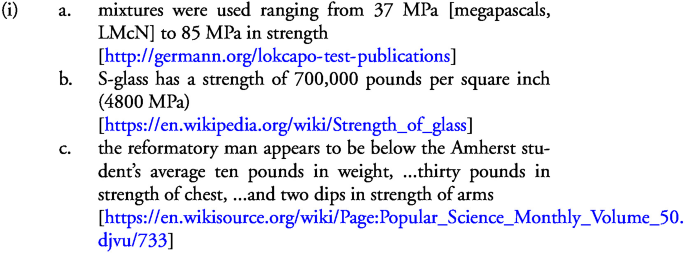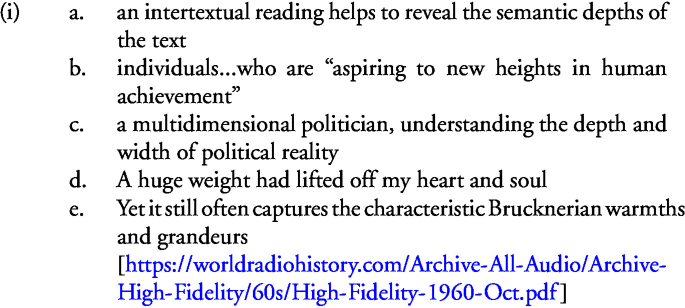Abstract
Degree semantic analyses of gradability and measurement have been very successful, but they are highly abstract. Solt (2016) suggests ways to connect such analyses to facts about the mental representation of quantity and measure. The goal of this paper is similar in mission, but draws on polysemy data. The English -th nouns expressing measurable dimensions (breadth, depth, height, length, warmth, weight, width) all have uses describing measurable properties (e.g. 2 meters in breadth/depth/height/length/width, 2 kilos in weight, 115 degrees in warmth). However, they all have other, interestingly diverging senses. Heights and depths are geographical formations; weights are also physical objects, if of a different sort. None of the other measure nouns name physical objects in the absence of a complement. Lengths of rope, breadths of sand, and widths of fabric can all describe physical objects with a particular measure, whereas heights of poles, depths of water, and weights of yarn only describe measures. Warmths of wood, in contrast, are neither objects nor measures, but rather properties. I argue that these patterns can be explained by taking into account whether the properties in question can be measured according to ratio scales, and if so, how the “zero” value for the scale is determined; and that despite their abstractness, formal scales do mirror cognitively salient aspects of measuring.
Access this chapter
Tax calculation will be finalised at checkout
Purchases are for personal use only
Notes
- 1.
As the Merriam-Webster Online Dictionary and other sources note, in some cases, the suffix has simplified from [\(\theta \)] to [t].
- 2.
Although searches of the internet uncover examples of strength with measure phrases, such as in (i), no comparable examples are attested in COCA.

Note that the measures in the first two examples are not exactly comparable with the third, since the first two involve a highly technical measure of tensile strength, while the third appears to involve a relatively heuristic measure of the amount of weight a set of muscles can move or support without collapsing. Given the evident complexities involved in measuring strength and the length limits on this contribution, I leave strength out of the study.
- 3.
Specifically, the study drew on a database of nouns constructed at the University of Rochester Quantitative Semantics Lab from a local installation of COCA. The database used the Fiction, Popular Magazines, Newspaper, and Academic genres in the corpus (the Spoken genre was not included), which total about 350 million words. The corpus was tagged and dependency parsed using the Stanford CoreNLP tools (de Marneffe et al. 2014), and information both from the parse and from the CELEX database (Baayen et al. 1995) was added to the database. Note that all local installations of COCA have a random 5% of the corpus tokens removed for copyright protection purposes, and sentences containing html code or that were beyond a certain length were also excluded from the database creation pipeline because they posed parsing difficulties; see Grimm and Wahlung (to appear) for further details. Thus, the numbers cited here would differ slightly if based on searches of the relevant sections of COCA using the interface at https://www.english-corpora.org/coca/.
- 4.
Unless otherwise indicated, all examples in this section are drawn from COCA. Most of the nouns have metaphorical uses in addition to those discussed in the text; the examples in (i) are illustrative.

Due to space limitations, I will leave such uses out of the discussion, except for very briefly when I turn to breadth and width.
- 5.
I will not take a position here on how best to model polysemy. See e.g. Vicente and Falkum (2017) for an overview of different possibilities.
- 6.
Note that describing the direction as inward covers not only the intuitive association of depth with downwardness, when the exterior corresponds to the Earth’s surface, but also cases in which the direction involved is upward into the interior of a volumetric space, as when one talks about the depth of a ceiling.
- 7.
See Umbach and Leßmöllmann (2019), starting at min. 32:57, for a wonderful exemplification by Manfred Bierwisch of the role of perspective in the description of dimensional properties.
- 8.
Giorgos Spathas (p.c.) observes that the adjectives deep, high, and long—but not the rest of the adjectives related to the -th nouns discussed here—also seem to have such an interpretation.

How best to analyze such examples is an interesting question for future research.
- 9.
The idiomatic temporal expression at length also has a coordinate-like use to describe a point in the future, as in (i-a); however, this use is less frequent in COCA than the use of the same expression to describe an extension of time, as in (i-b).

I speculate that the temporal extension use is related to the physical location use described immediately below.
- 10.
Width would sound very odd in such examples, presumably because it lacks the areal implications that support the metaphorical extension to e.g. fields of knowledge.
- 11.
As Giorgos Spathas (p.c.) points out, the differences in the way the zero point is determined effectively correspond to differences in the measure functions we can associate with each noun; fully formalizing these measure functions would therefore almost certainly yield additional insights into the polysemy patterns. For example, we might consider different strategies for underspecifying the way the initial endpoint marking the linear distance is identified in the case of depth, height and length, and not underspecify this aspect of the semantics for breadth or width, as an approach to capturing the difference between these sets of nouns.
- 12.
Length might arguably be measured by ignoring surface contours, but unlike height and depth, it is not necessarily measured by ignoring them.
- 13.
Of course, the perception of weight depends on, e.g., gravity or atmospheric pressure, but these factors are more predictable, especially across a set of humans in the same environment, than those influencing temperature perception.
References
Anderson, M. D. (2012). Effect of gaspers on airflow patterns and the transmission of airborne contaminants within an aircraft cabin environment. Master’s thesis, Kansas State University.
Baayen, R. H., Piepenbrock, R., and Gulikers, L. (1995). Celex2 ldc96l14. Web Download. Retrieved September 20, 2020.
Broselow, E. (1977). Language change and theories of the lexicon. In Papers from the 13th Regional Meeting of the Chicago Linguistic Society, pages 58–68.
Davies, M. (2008). The Corpus of Contemporary American English: 450 million words, 1990-present. Available online at http://corpus.byu.edu/coca/.
de Marneffe, M.-C., Dozat, T., Silveira, N., Haverinen, K., Ginter, F., Nivre, J., and Manning, C. D. (2014). Universal Stanford Dependencies: A cross-linguistic typology. In Proceedings of 9th International Conference on Language Resources and Evaluation (LREC 2014), pages 4585–4592.
Grimm, S. (2012). Abstract nouns and countability. Talk presented at the LSA Annual Meeting, Portland, OR, January 5–8.
Grimm, S. (2013). Individuating the abstract. In Etxeberria, U., Fălăuş, A., Irurtzun, A., and Leferman, B., editors, Proceedings of Sinn und Bedeutung 18, pages 182–200. Online: http://semanticsarchive.net/sub2013/.
Grimm, S. and Wahlang, A. (t.a.). Determining countability classes. In Kiss, T., Pelletier, F. J., and Husić, H., editors, The Semantics of the Count/Mass Distinction: Recent Developments and Challenges. Cambridge University Press, Cambridge.
Merriam-Webster.com (2020). Words at play/usage notes: The height of mispronunciation—Or not. https://www.merriam-webster.com/words-at-play/the-height-of-mispronunciation2014or-not. Retrieved September 20, 2020.
Solt, S. (2016). Degree and quantity: Semantics and conceptual representation. Talk presented the workshop “Referential Semantics One Step Further: Incorporating Insights from Conceptual and Distributional Approaches to Meaning,” ESSLLI 28, Bolzano, IT, August 24.
Stevens, S. S. (1946). On the theory of scales of measurement. Science, 103(2684):677–680.
Umbach, C. and Leßmöllmann, A. (2019). Strukturelle Grammatik, semantische Universalien und Arbitrarität – ein Gespräch mit Manfred Bierwisch. Interview recorded at the Akademie der Wissenschaften, Berlin. Retrieved September 20, 2020.
Vicente, A. and Falkum, I. L. (2017). Polysemy. In Oxford Research Encyclopedia of Linguistics. Oxford University Press.
Acknowledgements
Thanks to Stephanie Solt for many interesting discussions, meals and excursions over the years, especially during my stay in Berlin in 2017–2018. Thanks also to Nicole Gotzner and Uli Sauerland for the opportunity to contribute to this volume, to Giorgos Spathas and Beth Levin for comments and suggestions, and to Scott Grimm and the Quantitative Semantics Lab at the University of Rochester for creating the noun database and Lexometer data visualization tool that facilitated this study. This work has been supported by FFI2016-70645-P (AEI/MINECO/FEDER) and an ICREA Academia award.
Author information
Authors and Affiliations
Corresponding author
Editor information
Editors and Affiliations
Rights and permissions
Copyright information
© 2022 The Author(s), under exclusive license to Springer Nature Switzerland AG
About this chapter
Cite this chapter
McNally, L. (2022). Representing Measurement: The View from Nominal Polysemy. In: Gotzner, N., Sauerland, U. (eds) Measurements, Numerals and Scales. Palgrave Studies in Pragmatics, Language and Cognition. Palgrave Macmillan, Cham. https://doi.org/10.1007/978-3-030-73323-0_10
Download citation
DOI: https://doi.org/10.1007/978-3-030-73323-0_10
Published:
Publisher Name: Palgrave Macmillan, Cham
Print ISBN: 978-3-030-73322-3
Online ISBN: 978-3-030-73323-0
eBook Packages: Social SciencesSocial Sciences (R0)





